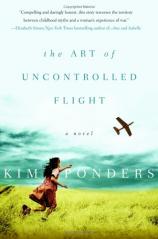The Art of Uncontrolled Flight
Review
The Art of Uncontrolled Flight
The cover of Kim Ponders's debut novel shows a little girl, arms outstretched, chasing a model airplane that flies just outside her grasp. The image is strong but not particularly original; indeed, it seems almost obvious and perhaps a bit clichéd --- a girl chases a dream, the memories of her mother and the truths her father hides from her, all symbolized by the gliding, soaring, elusive object. It's a lovely image, but its sweet and simple symbolism does not do justice to the complexity of Ponders's themes and the stark unsentimentality of her prose.
THE ART OF UNCONTROLLED FLIGHT is Annie's story. It begins when she is six years old, watching her mother emotionally disintegrate as they wait for her father's intermittent and brief returns from his service in the Air Force. And while cameo appearances by Annie's father only strengthen her adoration for him, they drive her mother slowly mad, to the point where she can no longer survive the perpetual state of emotional and physical limbo he has left her in. After her mother's death, Annie and her father bounce from town to town, woman to woman, family to family, and Annie's young adulthood is marked by perpetual movement. Her father may have left the Air Force but he remained always on the verge of takeoff.
Annie's character is marked by a core determination and a sense of resolve. Her steely nature and adoration of her father lead her to pursue a career as a fighter pilot where she matter-of-factly suppresses any remnants of femininity in order to succeed.
It is in the descriptions of Annie's military training, her relationships with her fellow pilots and the one event that almost destroys her that the novel itself really takes off. Annie's reflections on war and fear, on courage and sexuality, are distinctive and refreshing; her steely courage and unsentimentality mark her as an atypical brand of female narrator.
Despite the novel's pretense to be a work of fiction, a quick scan of Ponders's bio reveals her own aviary and military history; we as readers can only imagine that much of Annie's vividness, the way she leaps off the page, is a testament both to the author's skill and to her very personal connection to Annie's military and emotional struggles. But the narrative appeals of the book are also due to Ponders's technical skill as a writer. The novel is short and spare, but never feels incomplete; despite her brisk and unsentimental narrative tone, Annie is a fully-drawn and compelling character. Through her penetrating, un-shirking gaze, we see both familiar themes of family and sexuality, guilt and past, as well as the unfamiliar themes of the early-'90s Middle Eastern conflict and the role of women in the Air Force. Finally, the novel itself is tightly woven, marked by moments of startling lyricism and lovely thematic symmetry.
THE ART OF UNCONTROLLED FLIGHT begins and ends with an act of flight --- one unexpected and desperate, the other planned and prepared; one driven by anger, the other by love; both marked by the strange incongruous freedom of soaring into the unknown.
Reviewed by Jennifer Krieger on December 22, 2010
The Art of Uncontrolled Flight
- Publication Date: September 1, 2005
- Genres: Fiction
- Hardcover: 192 pages
- Publisher: HarperCollins
- ISBN-10: 0060786086
- ISBN-13: 9780060786083








